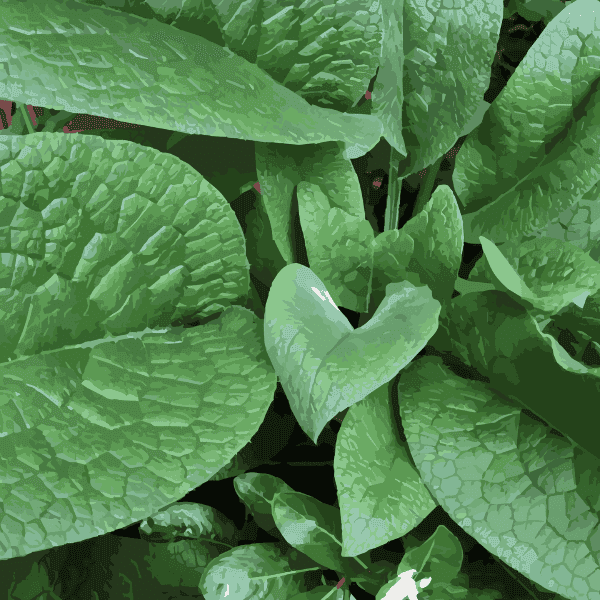
Comfrey Leaf {Organic}
Comfrey leaf, from the Symphytum officinale plant, is esteemed for its many benefits in herbal medicine. It is often used topically in herbal ointments and poultices to support wound healing and soothe skin irritations. Comfrey leaf is valued for its high allantoin content, a compound believed to promote cell regeneration and reduce inflammation, making it a popular choice in natural skincare and herbal medicine.
You might need Comfrey if . . .
- You suffer from skin issues
- You have muscle and joint discomfort
- You need support for skin health
Benefits of Comfrey
- Reduces swelling and bruising
- Soothes skin issues
- Great for bone health
Common ways to use Comfrey
As of 2016, an estimated 20.4% of U.S. adults (50.0 million) had chronic pain, and 8.0% of U.S. adults (19.6 million) had high-impact chronic pain. Studies have found the topical application of comfrey beneficial for many forms of pain, including muscle and joint pain and upper and lower back pain. Other studies have seen consistently promising results for arthritis pain when using topical comfrey without any adverse events. Due to comfrey’s antibacterial, antifungal, and anti-inflammatory properties, comfrey can provide exceptional wound-healing properties. Additionally, studies suggest comfrey’s allantoin compounds induce a wound-healing mechanism due to the regulation of inflammatory response and stimulus to fibroblastic proliferation and extracellular matrix synthesis.
🌿Try making herbal extractions or this DIY herbal soothing bath. ← 🟩 DIYs, recipes, and more!
Growing and Foraging Information
Comfrey thrives in USDA hardiness zones 3 to 9 and prefers full sun to partial shade and well-drained rich soil. It can be grown from seeds, root cuttings, or transplants, with leaves best harvested in late spring to early summer for their highest nutritional content. Foraging for wild comfrey is possible but should be done carefully to ensure proper identification, as it can easily be confused with other plants.
Safety Concerns
Comfrey does contain pyrrolizidine alkaloids which can be toxic to the liver when used over extended periods in large doses. Allergy to comfrey is rare but possible. It is also possible for it to interact with certain medications affecting liver function.
Drug Interaction: If you have any health concerns or are taking any prescription medication, please consult with your health care provider before adding new herbs to your diet.
Breastfeeding and Pregnancy: The mainstream claims comfrey is possibly safe when used on unbroken skin in small amounts for less than six weeks. However, the poisonous chemicals in comfrey can pass through the skin, so it is possibly unsafe to use comfrey on broken skin or to apply large amounts for more than six weeks. Additionally, the mainstream claims comfrey is likely unsafe when taken by mouth or applied to the skin while pregnant or breastfeeding. The pyrrolizidine alkaloids (PAs) in comfrey are absorbed through the skin and might cause congenital disabilities. They urge to avoid use during pregnancy and breastfeeding.
Other Concerns: According to trusted herbalist Richard Whelan, external applications of comfrey leaf and root are no problem regarding potential toxicity and work beautifully. He states he uses a great deal of comfrey leaf and root in compresses and creams for a person with wounds or sores that are not healing well.
However, the internal use of comfrey has to be undertaken with great sensitivity and care, or not at all. Comfrey has real potential to harm the liver. Comfrey has performed further little miracles in my practice to this day. Still, Whelan uses it rarely and extremely carefully (doing frequent blood tests in my clinic while the patient uses it to look for characteristic hallmarks of liver stress). Richard would counsel anyone not trained in herbal medicine or who has undergone rigorous study into the scientific literature of comfrey to refrain from self-medicating with this plant internally.
Select Studies About Comfrey...
A critical scoping review of external uses of comfrey (Symphytum spp.)
External preparations of the herb comfrey (most commonly Symphytum officinale L.) are widely available for over-the-counter, practitioner, and healthcare professional use. Traditional practice suggests comfrey can be used to treat musculoskeletal disorders, wounds, and various other conditions; however, a full and critical coverage of the evidence base has not yet been undertaken.
Comfrey: ancient and modern uses
For over 2,000 years, comfrey root and other parts of the herb have been used to treat various ailments. The plant (Symphytum officinale L) belongs to the family Boraginacea and has been valued in traditional medicine for its anti-inflammatory, analgesic and astringent properties.